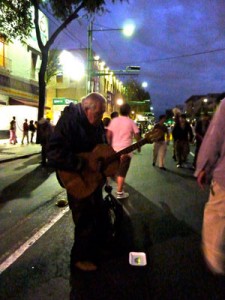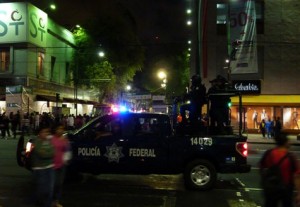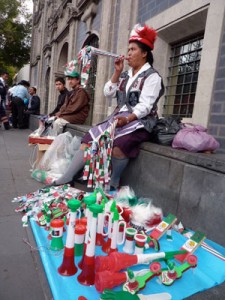On the night of Mexico’s bicentennial celebration, an old man was strumming his acoustic guitar. He was on a dark avenue surrounded by the din of crowds, festive cries and police sirens. His guitar had no amplification, and the bowl at his feet only had a few coins, but he was playing so intently that I stopped to listen. I had to get really close to hear the melody, but it was worth it. Like a rowdy family gathering that goes quiet because Grandpa starts to tell a story, the din around me faded.
The crowds kept moving and nobody stopped to listen, and I don’t blame them. There were so many things to see and hear this Sept. 16: a massive float car parade with dazzling colors, beautiful dancers dressed in fantasy costumes and a dizzying landscape of red, green and white celebrating the Mexican flag. Earlier in the day, I saw the BBC News interview with event organizer Ric Birch, producer of Olympic opening ceremonies in 1992 and 2000. He said this might be one of the biggest and boldest events in recent memory, and indeed, the spectacle did not disappoint.

(See the BBC photo slideshow here.)
However, the bold plans were not highlighted in the media. Instead, the focus was on depressing headlines like “Drug War Woes Dampen Mexico’s Bicentennial Party” (NPR) , “On 200th birthday, Mexico battered but not broken” (Associated Press), “Why Mexico Is Anxious About Its Bicentennial” (The New York Times), or this one from the Dallas Morning News: “Mexico marks 200 years of independence under shadow of violence, poverty,” which I saw while boarding my connecting flight. Although optimistic points were made, one of the only (pre-celebration) articles I found without blatant cynicism about violence and poverty was China’sXinhua News, which discussed how the parade would proudly showcase Mexico’s cultural legacies. Of course, the bias is justifiable because the U.S., unlike China, is directly affected as Mexico’s neighbor.
A peculiar coincidence made the media bashing even more irresistible: Each 100 years, Mexico appears to plunge into chaos. In 1810, the Jesuit-trained priest Miguel Hidalgo made the famous cry for independence, or grito, from Spain, which sparked a decade-long bloody struggle. In 1910, the peasant revolution began against Porfirio Diaz‘s dictatorship, which reaped even higher death tolls. And now, in 2010, well … there’s the drug war, which is nowhere as terrible, but it offers some convenient parallels.
Time magazine wryly mentioned that as far as some Mexicans are concerned, the Mayan prophesy of cataclysm in 2012 may have been generous, since Mexico’s history has “an eerie way of repeating itself” and “the sky’s actually going to fall next year.” Doomsday fascination is enticing especially when it’s south of the border.

The sky could have fallen last night, literally, if the gigantic statue that was being erected in the middle of the crowd of 60,000 people had collapsed. In a grand feat of engineering courage (from the perspective of someone underneath the thing), the white statue of the “heroes of independence” standing more than 60 feet tall was miraculously pieced together and raised by a crane mid-spectacle. The pyrotechnic display of flames above the National Palace was also a nail-biter, as was the choreography of dancers suspended in space on a vertical net, a performance that climaxed with human bodies spelling the word “Mexico” in the air. Even the parade leading to the Zócalo was impressive, with dozens of float cars and costumed dancers (produced by 1,200 artists and 3,000 volunteers) celebrating different aspects of the country’s culture: mambo music, the Day of the Dead, and the legacy of peasant farmers.

The event planners were brave in their exorbitant displays, but they did not fool around with security. The Zócalo was heavily guarded by police blockades to prevent overcrowding. Even intersections at obscure streets had a dozen cops posted. Only after multiple attempts was I allowed back in my hotel since it was located in an “off-limits” downtown area. Incredibly, for a party-happy country like Mexico, a “dry” alcohol measure (ley seca, see article in Spanish here) was instituted within city limits for the three days around the holiday, allowing booze to be sold only in restaurants and bars, not on the street. The result was an extremely safe event — although the price tag was hefty.
“For the cost of a warplane, you can celebrate the birthday of a country,” said Marco Balich, an artistic director of Olympic ceremonies as quoted by NPR, referring to the event’s $40 million-plus cost. This spurred media bashing from Mexico itself, with outlets like El Semanario, Noroeste, and Reforma criticizing the bicentennial’s enormous expenses. “What is there to celebrate?” asked Reforma, one of the nation’s most influential papers, when 49 percent of the population is under the poverty level and the country is being ripped up by drug cartel violence? Nevertheless, the articles did service to the country’s milestone year by wrestling with the task at hand: What has caused the country’s ills, and what is needed in the future? What stronger democratic and governmental institutions are needed to continue the country’s evolution? Without a clear “rule of law,” as discussed in one review of the bicentennial celebration, the country is bound to repeat its past mistakes.

The parade culminated with the traditional cry of independence at 11 p.m., the “grito” led by President Felipe Calderon from the Zócalo yelling “Viva México!” Music shows went into the night on five big stages around the city. One of the last acts I saw was at the stage next to the Angel of Independence, a commemorative statue. Between her rock songs, the singer Paulina Rubio explained what the bicentennial meant to her: “I’m proud to be singing under the Angel, celebrating, because happiness is the most important thing for us right now. We need happiness to envision a Mexico in peace, a Mexico without violence.” Even if the price tag was high, people needed the celebration.
I remembered the acoustic guitarist I had met playing alone in the street. I had asked him about the head of his guitar, which was once broken and appeared to have been fixed with some ingenuity; he strummed his guitar proudly to show the sound was still good. Away from the lights that dazzled his compatriots that night, the guitarist played his own song. Perhaps that is how Mexico will be in the next 100 years: mending its broken wounds, playing a quiet and hopeful song.
Kristian Beadle is writing a book about the effects of climate change in Mexico, based on his recent trip, the Voyage of Kiri. For more information, see www.voyageofkiri.com.




